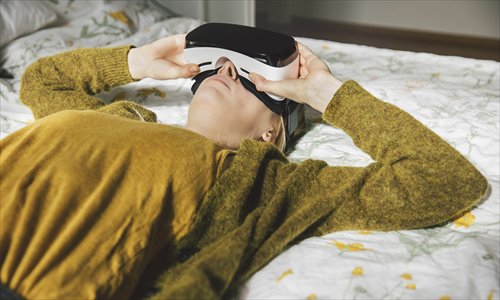Can virtual reality hurt?

To protect their health, experts caution first-time VR users against exceeding one hour of play in their first sitting. Photo: IC
Standing in front of some weird egg-shaped chairs, 24-year-old Nina Huang carefully looked inside before sitting. She then put on the virtual reality (VR) headset and got ready to experience an adventure.
She is one of an increasingly large population who are trying VR games in shopping malls across Beijing. In keeping with the trend, the Longfor Beijing Changying Shopping Center in Chaoyang district launched Beijing's Technology Month of Virtual Reality in May. Wang Zhiyong, an employee at the mall, said around 100,000 visitors play VR games such as skiing and rowing daily.
Although very popular among the hip and trendy in China, VR is not new. According to a May 16 report by China Business News, China's VR market has been flourishing over the last five years and the market size is expected to reach $8.5 billion, as many Internet and technology giants like Alibaba, Baidu and Tencent are developing VR business.
However, experiencing the trend may come at a cost. After 20 minutes, Huang began to feel uncomfortable.
"I felt dizzy," she said. "I rode a virtual roller coaster and played with giant Frisbee for about 20 minutes. When the roller coaster reached the highest point, we hung upside down. It felt so real."
Huang is not the only one to feel disoriented after using virtual reality technology. Deng Yiyun, a 23-year-old Chinese student who studies in London, felt sick within the first few minutes of experiencing VR in her university.
Deng wore a heavy VR headset for about 20 minutes while participating in a nerve science project in her university's lab. "It took me 30 minutes to feel better," she said. "I don't want to experience it anymore, unless VR improves its own technology [for better user experience] in the future."
As more people begin to try VR, some, like Huang and Deng, have experienced adverse side effects, such as eyestrain, dizziness and balance disorders, which may last hours or days. This has drawn public attention to VR's possible bad effects.
Marty Banks, a professor of optometry and vision science, and affiliate professor of psychology and bioengineering at the University of California, Berkeley, attributes some of these side effects to something called vergence-accommodation conflict, the news portal sina.com reported in March. Banks said that even though the phenomenon is temporary, people shouldn't ignore its long-term effects.
Albert Rizzo, the director for medical virtual reality at the Institute for Creative Technologies at the University of Southern California, shares Banks' opinion.
"A certain percentage of the population, maybe 10 to 20 percent in all, can't stick to VR scenes more than 10-15 minutes; otherwise, their body will feel uncomfortable," he told Metropolitan.
Rizzo, who has 22 years of experience in VR research, said the "virtual" aspect of the technology tends to impact negatively on how the brains of some users perceive things.
He took a roller coaster for an example. "When you are in the real world, you go up and go down fast. It's not just virtual. Your body is feeling stuff. However, if you are on a virtual roller coaster, you will see it, but you are not moving. It's [the] same virtual stimulation, but you are not getting body stimulation, and that throws the brain off."
According to Rizzo, the response time to the technology may vary according to user sensitivity. "For some people who feel uncomfortable, the first five seconds is too much. For others, maybe it's a couple of hours," he said.
Rizzo suggested that users not wear VR headsets for more than an hour, especially first time users. "Taking a break to relax one's eyes is crucial," he said.